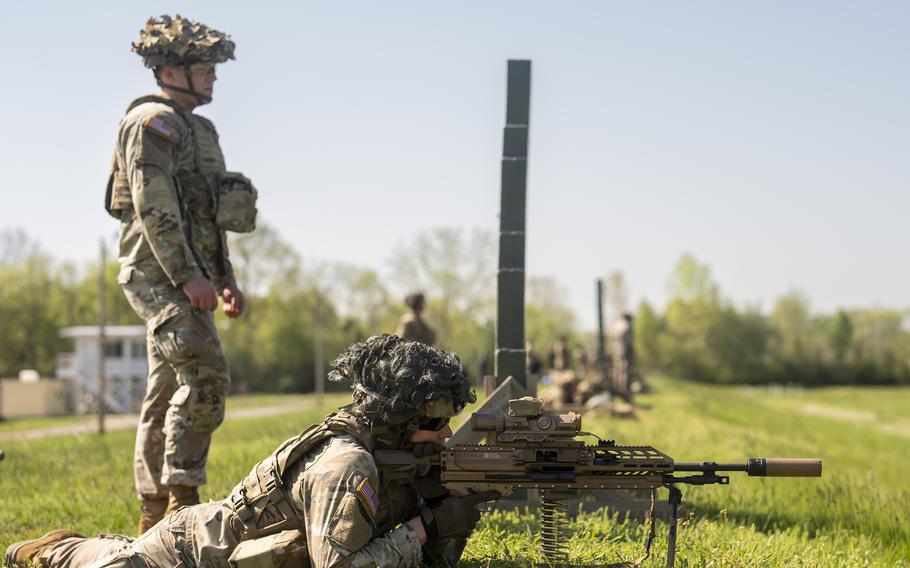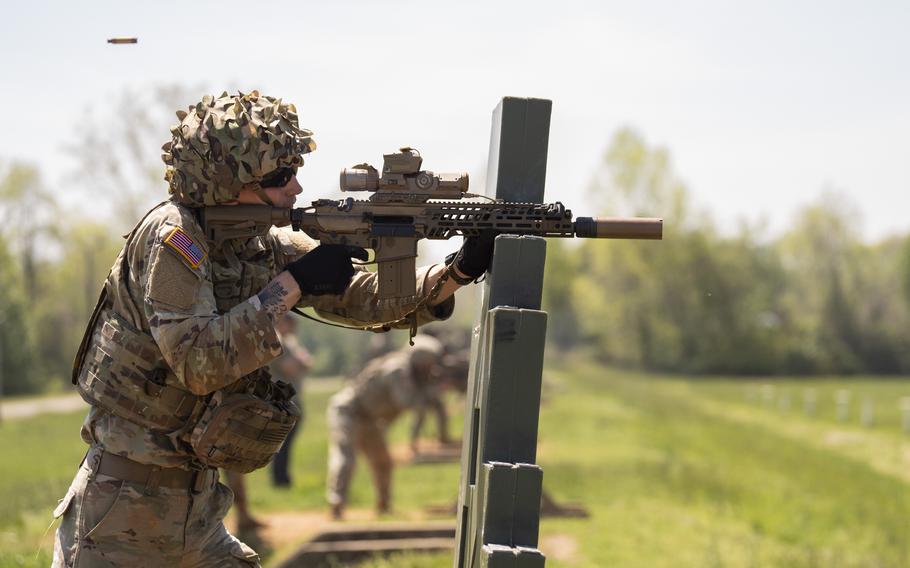
A 101st Airborne Division soldier fires the XM250 automatic weapon during training at Fort Campbell, Ky., on Monday, April 15, 2024. (Jason Amadi/U.S. Army)
Army Sgt. Marcus Colston squeezed the trigger on his new XM7 rifle and sent a round speeding toward a target protected by a 3/8th-inch steel plate.
The XM7’s 6.8mm round tore through the plate, striking Colston’s small target, the infantryman said shortly after firing the weapon for the first time Monday at Fort Campbell, Ky. He continued pulling the trigger, sending more rounds through steel plates and cinder blocks and into targets.
“Straight through. Every single shot,” said Colston, who had previously been using the Army’s standard M4 carbine throughout his four years in uniform.
Colston’s unit — the 101st Airborne Division’s 1st Brigade Combat Team — recently became the Army’s first brigade to field the XM7 rifle officially and the Army’s new XM250 squad automatic weapon. Both built by Sig Sauer, the weapons are envisioned to replace the aging M4 carbine and M249 medium machine gun in the Army’s close combat forces, such as infantry, armor and special operations formations.
Col. Trevor Voelkel, who commands the 101st’s 1st Brigade, said his soldiers were taking “a lot of pride” in being the first to field the XM7 and XM250, which have been under development for years in the Army’s Next Generation Squad Weapon program.
“With that pride is the understanding of the gravity of us fielding and doing this correctly, and providing immediate feedback to the Army if there is something that we’re seeing that isn’t meeting expectations,” Voelkel said Monday, shortly after he shot the new rifle for the first time. “So, there’s a lot of pride and a lot of excitement based on the capabilities of this new weapons system, and then on the serious side, there’s a gravity of understanding here, that we have a responsibility to continue to provide good feedback to the Army.

A 101st Airborne Division soldier fires the new XM7 rifle during training at Fort Campbell, Ky., on Monday, April 15, 2024. (Jason Amadi/U.S. Army)
Voelkel and Colston walked away impressed with their initial shooting of the XM7 and the new-to-the-Army 6.8mm round it shares with the XM250. Colston said while the XM7’s rounds easily punched through the steel plates on Monday, the 5.56mm rounds that he shot with an M4 “barely bulged the back” of the plates.
“I think they really hit their mark,” with the rifle’s design, Colston said. “I don’t think anybody with body armor is going to be able to survive a round from the XM7. Light-skinned [armored] vehicles — same story. The penetration from the round is just a huge improvement over the M4.”
The added stopping power is the point of the new weapon, Army officials have said throughout its development. Army studies in recent years showed 5.56mm rounds might not be powerful enough in a fight against China or Russia, who have advanced body armor unlike most of the insurgent forces that U.S. troops have fought in the Middle East, Afghanistan and Africa in recent decades.
However, the rifle’s added punch comes with some potential disadvantages. At slightly more than 10 pounds, the XM7, which will soon drop the X for experimental from its name, is heavier than the M4’s roughly 6.4 pounds. Soldiers who have fired both weapons have also said the new rifle has a stronger kickback after shooting.
Staff Sgt. Garrett Steele, another soldier from the 101st’s 1st Brigade, said the added weight and recoil were not “all that noticeable” while he was firing it.
Steele said he gave the XM7 top marks among rifles that he has fired, noting the new optic that the Army is fielding with the weapon was a “huge improvement.” Voelkel, who has served as an infantry officer for more than 20 years, called the optic “a game-changer.”
The XM157 Fire Control optic — built by Vortex Optics — mounted on the XM7 and XM250 is equipped with laser range finders, ballistics calculators and compasses to help soldiers quickly adjust their targeting for weather and other conditions in the field.
“I love the optic,” said Steele, an 11-year infantryman. “It honestly makes the heavier weight worth it. You can get on target faster, your precision goes up — more rounds faster and more accurate on targets downrange.”
The Army plans to purchase some 18,000 XM7 rifles and more than 1,700 XM250 automatic weapons next year, according to the service’s fiscal 2025 budget request. The Army intends to purchase more than 111,000 XM7s and more than 13,000 XM250s by the early 2030s, according to the budget request sent to Congress last month.
The 101st soldiers will spend the coming weeks putting the new weapons through their paces and delivering any feedback soldiers have to the Army and Sig Sauer, Voelkel said. A National Guard armored brigade will be the next to field the XM7 and XM250 in May, according to U.S. Army Futures Command.
“I think we’re going to get used to the weight and how to carry this new weapons system,” Voelkel said. “That’s the biggest thing, I think, you grab it and [realize] it is a lot heavier.
“But these soldiers — once they saw the energy on target it was able to produce, they kind of say ‘OK, I just need to hit the gym a little bit more and work on my biceps.’ It’s worth it.”